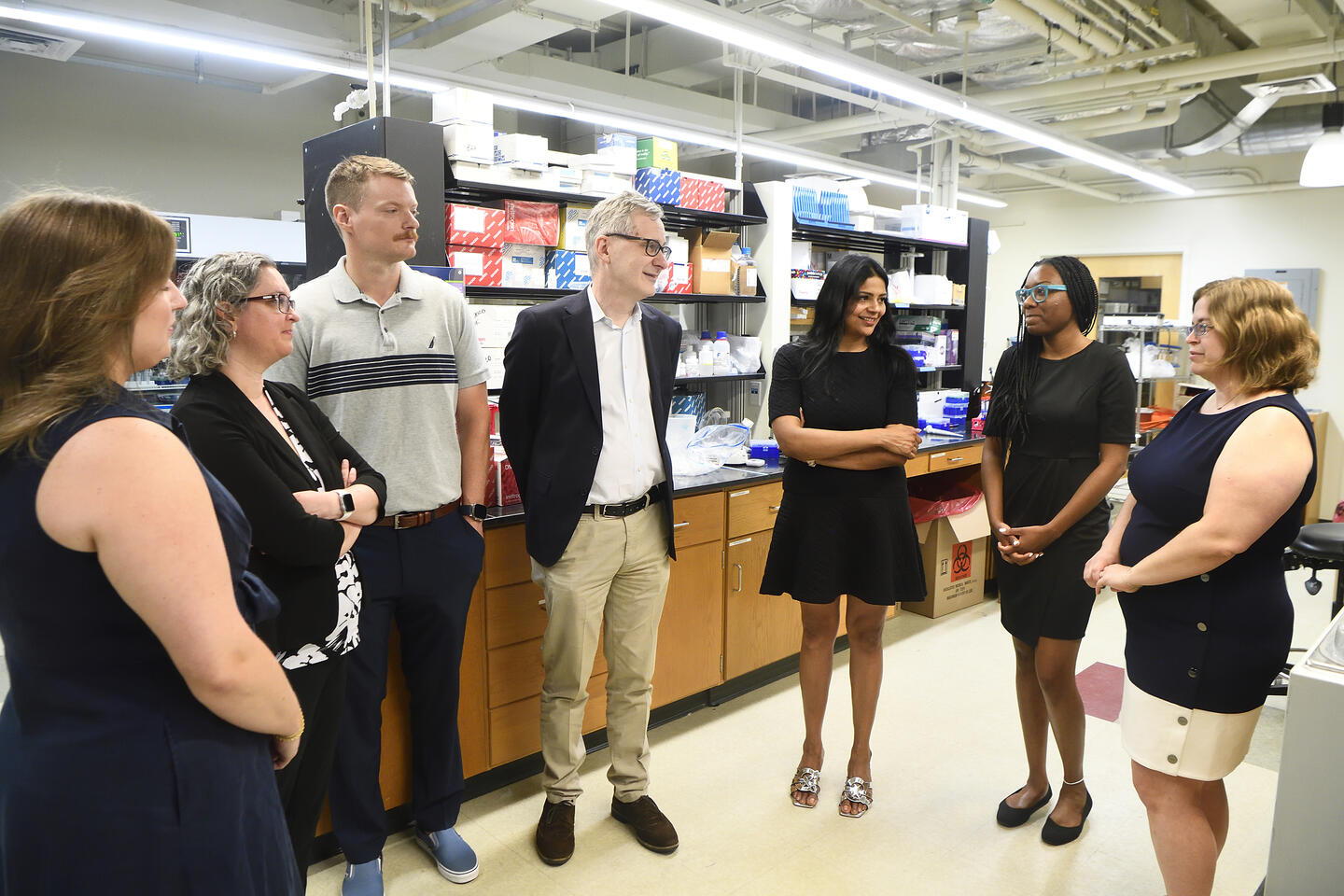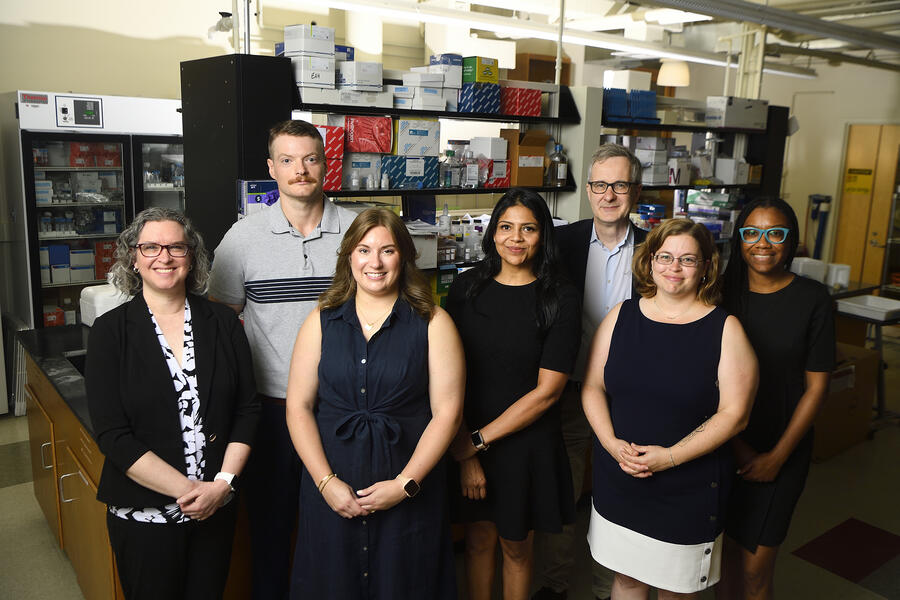Scholars and scientists know well the grueling late-night and weekend hours it takes to write a grant proposal. And the bigger the grant, the more hours required.
That's why, in 2017, Johns Hopkins University created a research development team—known simply as RDT—to support faculty through the laborious process of developing and submitting proposals for research funding, particularly highly competitive, large-scale grants that involve collaboration across disciplines. Earlier this year, RDT surpassed a major milestone to bring in $500 million—and has now secured $670 million in research funding to the university since it launched seven years ago.
But it's not stopping there. "Our goal is to march toward $1 billion and beyond," says Declan Sunderland, the grants manager for RDT, which started as an experiment with a couple of employees but has now bolstered its presence in Johns Hopkins' Office of the Provost.
Staffed with senior science writers, a grants and contracts team, and a director of research, Chasmine Stoddart, RDT offers a range of services for not only faculty but also postdoctoral fellows and graduate students through funding opportunity lists that are released monthly. RDT's core services include:
- Managing and facilitating the entire pre-award phase, including budget development
- Ensuring the proposal has "one voice" through scientific editing
- Simplifying complex concepts with compelling graphic designs
- Providing "ready-to use" templates for common sections in proposals
In addition, RDT introduces researchers and principal investigators to potential collaborators, helping to cultivate multidisciplinary research across departments, schools, and institutions—a key goal of the university's Ten for One strategic plan. The team also sends weekly notices to alert researchers of funding opportunities and provide guidance on specific large-scale grants.
"The result is that scientists and researchers can focus on the science and research, while our team manages the rest," says Denis Wirtz, vice provost for research at Johns Hopkins who led the initiative to start RDT.
In large, multidisciplinary proposals, Wirtz explains, "the science is just a few tens of pages, while there are then hundreds of pages of administrative requirements—pages with biosketches, budgets, budget justifications, all kinds of tables. Faculty see this as a mountain to climb."
This is where RDT comes in—and part of why Wirtz and his team created it in the first place, making Johns Hopkins unique among universities in its offering of comprehensive proposal development support. "Other universities might send lists of funding opportunities or help with [broad ideas], but we were an early leader in offering support at a granular level, in a way that makes a difference," Wirtz says.
While support for faculty is part of the rationale, the primary driver of RDT is that "the world's most interesting science is happening at the interface of disciplines … with the vast majority of calls for proposals requiring multidisciplinary collaboration," Wirtz says. Fewer proposals ask for expertise in a single discipline. "Instead, one might want epidemiologists, biostatisticians, and engineers to come together to work on a complex, multidisciplinary problem."
Wirtz and his colleague Sue Porterfield—now the vice president for research at Kean University but previously the senior associate vice provost for research at Johns Hopkins—say they realized years ago that JHU had the skill set and talent to go after large-scale, multidisciplinary grants. "It was just a matter of organizing to make it happen," Porterfield says.
Porterfield, who holds a doctorate in organizational leadership, partnered with Wirtz and others—and put her skills to work. They first launched a smaller, separate version of RDT in JHU's Institute for NanoBioTechnology. Later, they made the program available across the entire university to researchers applying for funding opportunities of at least $5 million.
Today, most of the grants handled by RDT come from federal agencies like the National Institutes of Health, the National Science Foundation, and the U.S. departments of defense and energy. But they also come from private foundations, state agencies, and foreign governments. "We work with them all," Wirtz says. Some of the grants RDT has helped secure include:
A global research program of the International Maternal Pediatric Adolescent AIDS Clinical Trials Network (IMPAACT) to conduct a clinical trial to treat—and ultimately end—the epidemic of women, infants, children, and adolescents who have HIV or are affected by the virus
A new center to research and address drug use inequities across diverse tribal cultures and contexts, run by the Community-Driven Indigenous Research, Cultural Strengths, and Leadership to Advance Equity in Drug Use Outcomes (CIRCLE)
A longitudinal observational research registry for the study of medicinal cannabis use and health, created to inform clinical decision-making and steer policy and regulatory decisions in the interest of the public and patient health
A new center connected with Johns Hopkins' Center for Health Security to investigate links between environmental exposures and adverse health outcomes across Maryland—and to translate those findings into action in and beyond the mid-Atlantic region

Image credit: Will Kirk / Johns Hopkins University
Ryan Vandrey, an experimental psychologist in the School of Medicine's Department of Psychiatry and Behavioral Sciences, serves as co-principal investigator of the medicinal cannabis grant with his colleague Johannes Thrul. According to Vandrey, help from RDT made all the difference, allowing them to win a highly competitive NIH award of more than $10 million spanning eight years. "The application was 10 times more complex than the average grant submission, and the NIH was only going to select one awardee," Vandrey says. "If we had tried to do it on our own, it would have been a mad scramble."
Vandrey's experience started with Sunderland, RDT's grant manager, introducing him to potential collaborators across the university. A turning point was meeting Paul Nagy, the director of education in Biomedical Informatics and Data Science, and "discovering a whole infrastructure within Hopkins dedicated to doing EHR [electronic health records] research that we had no clue existed before Declan made that introduction," Vandrey says.
Sunderland went on to help Vandrey and Thrul team up with computer scientists from the Whiting School of Engineering and data scientists from the Bloomberg School of Public Health—and even find money to fund seed grants to junior scientists. "All of this stuff is way outside of my wheelhouse," Vandrey says. "But it enabled us to submit a much more appealing proposal, where we brought some of our own funding to the table and had a multidisciplinary team in-house, already picked out and ready to go," Vandrey says.
Likewise, Sunderland and his team "put budgets together, organized and coordinated everything, did the editing and formatting, and uploaded all of the forms," Vandrey says. "We just had to write the science, write the justifications, give them the numbers, and then they plugged everything in—this was huge."
Allison Barlow, an associate scientist in the Department of International Health at the Bloomberg School and executive director of the Johns Hopkins Center for Indigenous Health, benefited from RDT in similar ways. Together, she worked with her co-principal investigator Melissa Walls, an associate professor in the same department who serves as director of the Great Lakes Hub for the Center for Indigenous Health, to write a $12 million grant to create a center to research drug use among indigenous communities. Barlow describes RDT as "a great service at Hopkins and best-kept secret."
Barlow and Walls—the 2023 President's Frontier Award recipient—had "started working on the grant the previous year but put it aside because of a lack of bandwidth," Barlow says. The budgets alone involved subcontracts with investigators from other institutions and negotiations with tribal organizations, presenting challenges. But once RDT became involved, things got easier.
"They managed the budgets and timeline of the project, while taking on tasks like biosketches, which are always a nightmare, copyediting the proposal to unify the voice, and hiring a graphic designer to make the figures and tables consistent," Barlow says. This help enabled Barlow and Walls to "focus on the research content, aims, and themes—and produce a much better proposal," she says.
For the institution at large, RDT enables Johns Hopkins to continue growing as a leading research institution, where scientists and scholars work together to solve tough problems. "We started lean and mean and have evolved to land large center grants like P01s, P30s, U54s—the whole alphabet soup of NIH grants," Wirtz says of RDT.
In fiscal years 2022 and 2023, Johns Hopkins pulled in more NIH funding than any other U.S. college and university, according to the Blue Ridge Institute for Medical Research. And for 44 years running, JHU has led the nation in research and development funding from the federal government, according to the National Science Foundation's annual reports on higher education R&D.
"Some universities have tried to emulate this but haven't had the success we've had," Wirtz says. A key ingredient is hiring staff "who are completely adjudicated to the faculty and see success in the success of faculty landing these big grants."
There's humility in being a strong support staff like RDT—and humility in researchers stepping out of their silos to work as teams. "This is the secret sauce," Wirtz says.
To learn more about RDT's services, visit the RDT website, submit an inquiry, _or email RDT's team.
Posted in University News









